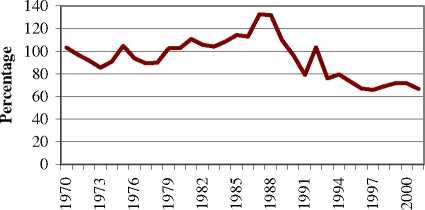K. Ludi: consumption behaviour in Zambia
Figure 5: Average Propensity to Consume in Zambia (1970 - 2001)

The APC in Zambia has remained at high levels during the past three decades, currently
at a level of 0.66. These rates are comparable to the industrialised and developed
economies of the World, such as the United Kingdom (APC = 0.77), the United States of
America (APC = 0.68) and Taiwan (APC = 0.6) (Abeysinghe and Choy 2004: 565). The
problem is that the APC in Zambia is not entirely stable: it has declined quite steadily
since the mid-1980s - PCE’s contribution to output is decreasing over time. This
therefore puts into doubt the existence of a built-in stabiliser in the economy. Since PCE
is the most stable component of aggregate demand, a decline in its contribution to output
implies greater contributions of more variable components, such as exports and
investment, which leads to cyclical and volatile output growth (Abeysinghe and Choy
2004: 577). Another puzzling and worrisome aspect of Zambia’s APC are the values
greater than one that occurred in the 1980s. This seems to be consistent with a
subsistence economy in the clutches of extreme poverty.
3. Methodology and Data
In line with approaches followed partly by Hatzinikolaou (1998), Drobny and Hall
(1989), and Appleton (2001), and completely by Abeysinghe and Choy (2004), PCE in
Zambia was estimated in two ways: the long-run determinants of PCE are estimated
according to conventional OLS; and the short-run determinants are analysed according to
the approach put forward by Engle and Granger (1987). In the case of analysing whether
the poverty-stricken in Zambia are temporarily poor or permanently impoverished, a
panel data analysis would be ideal - a case for further research.
More intriguing information
1. Integration, Regional Specialization and Growth Differentials in EU Acceding Countries: Evidence from Hungary2. On the origin of the cumulative semantic inhibition effect
3. The name is absent
4. The name is absent
5. Influence of Mucilage Viscosity On The Globule Structure And Stability Of Certain Starch Emulsions
6. The name is absent
7. The name is absent
8. Banking Supervision in Integrated Financial Markets: Implications for the EU
9. MULTIPLE COMPARISONS WITH THE BEST: BAYESIAN PRECISION MEASURES OF EFFICIENCY RANKINGS
10. The name is absent